Singapore and Malaysia held a ceremony at the Causeway on Thursday (30 July 2020) to mark the final official confirmation resumption of the Rapid Transit System (RTS) Link project.
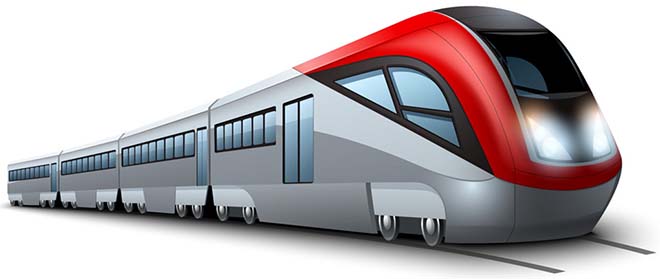
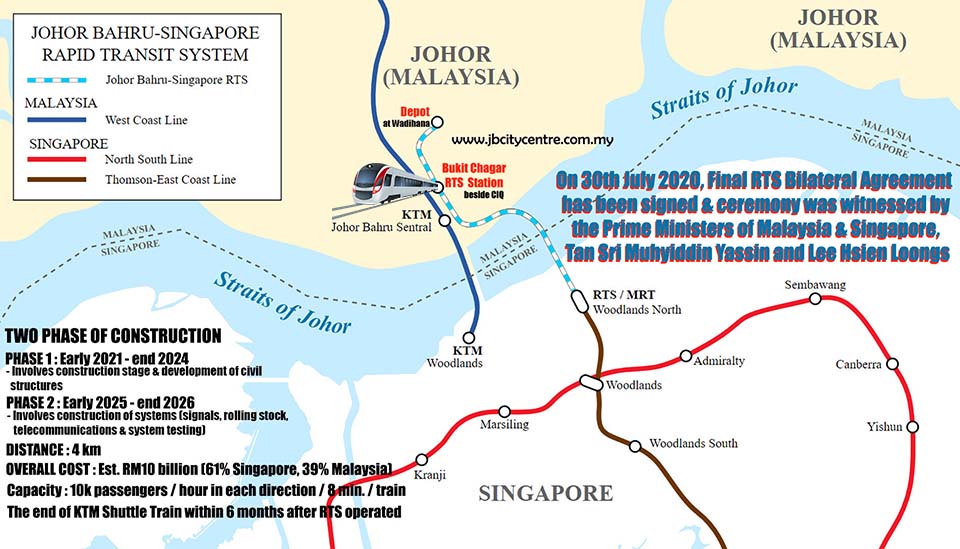
JOHOR BARU - The final three key agreements to resume the RTS Link project have been successfully concluded and signed by both countries authorities. This includes an agreement to amend the RTS Link Bilateral Agreement between the governments of Singapore and Malaysia. Additionally, a joint venture agreement between Singapore's SMRT RTS Pte Ltd and Malaysia's Prasarana RTS Operations Sdn Bhd to constitute RTS Operations Pte Ltd, as well as an agreement to appoint it as the operating company for the first 30-year concession period, were also concluded. The Singapore-incorporated RTS Operations will design, build, and finance the RTS Link operating assets including trains, tracks and systems. The company will also operate and maintain the rail line between Bukit Chagar in Johor Bahru and Woodlands North in Singapore.
"The RTS Link will continue to feature co-location of customs, immigration and quarantine (CIQ) facilities so that passengers undergo CIQ clearance only once at their point of departure," the joint statement said. Both sides reaffirmed their commitment to ensuring that the RTS Link stations will be "well integrated" with the local transport networks in each country, it added. Fares will be set by RTS Operations and will be determined closer to the date when passenger services start.
The price tag to see an upward revision of at least RM500 million from the earlier projected RM3.16 billion, according to Transport Minister Datuk Seri Wee Ka Siong. The cost revision is due to specification changes that include the setting up of a new depot, Wee told lawmakers in Parliament today. Wee is also the Barisan Nasional member of parliament for Ayer Hitam. Besides that, the project, which was previously based on the Mass Rapid Transit (MRT) system, has been switched to the Light Rail Transit (LRT) system, but the RTS system link capacity still same which can carry up to 10,000 passengers per hour in each direction during peak periods. "The previous cost was RM3.16 billion, but a new depot at Wadihana, Johor Bahru for train maintenance and repair needed to be built which switched from the existing Thomson-East Coast Line Mandai depot. The construction costs and security features add up to an additional RM500 million," he said. The Passenger service is targeted to start from end-2026 instead of the original end-2024 schedule. The RTS Link aims to connect Bukit Chagar in Johor Bahru to Woodlands in Singapore, serving about 10,000 passengers per hour each way to help ease traffic congestion on the Causeway.
The first phase of the project, comprising civil construction works, is expected to commence in January 2021, followed by the second phase in 2025, which will comprise systems works such as testing and commissioning. The entire project is expected to be completed in 2026. Meanwhile, Wee said the Malaysian government is considering switching from the deferred payment method to fund the project, to government funding via DanaInfra Nasional Bhd. "We are not limited to deferred payment. We may also fund the project via Danainfra, which has been discussed with the finance minister," he said, in response to a question from Datuk Seri Saifuddin Nasution Ismail (PH-Kulim Bandar Baharu). In terms of fare, the minister said riders from Malaysia will be paying the fare in ringgit, while those from Singapore will pay the same fare but in Singapore dollars.
For ease of commute, the RTS Link will have co-located Custom, Immigration and Quarantine (CIQ) facilities in both the Bukit Chagar station in Johor Baru and Woodlands North station in Singapore.
"Passengers travelling in either direction will clear both Malaysia and Singapore authorities at the point of departure, and need not go through immigration clearance again at the point of arrival," the statement said.
ROUTE, MAINTENANCE AND APPOINTMENT OF INFRASTRUCTURE COMPANIES
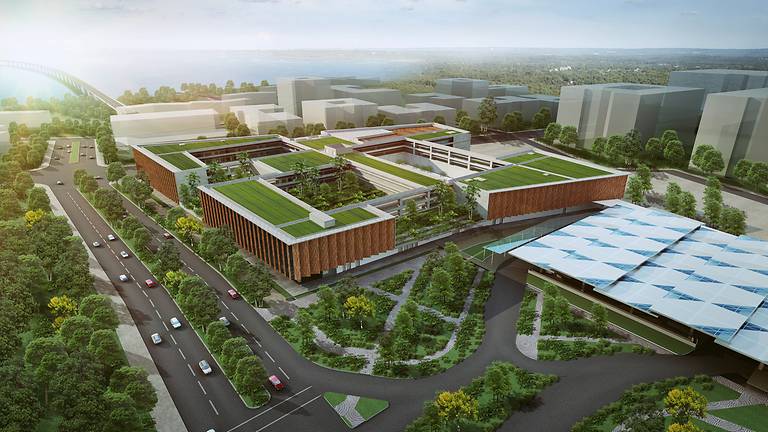
Artist’s impression of the train platforms at the RTS Link Woodlands North Station. (Image: LTA)
The media release also said the service will cross the Straits of Johor via a 25-metre high bridge linking both the stations. It said the RTS Link will utilise the same "four core systems" as the upcoming Thomson-East Coast Line (TEL). These systems include the same trains, signalling system, communications system and the Integrated Supervisory Control System.
Heavy maintenance will be outsourced to SMRT Trains, which will operate TEL. This will be done at its Mandai Depot, although there will also be a light maintenance facility at Bukit Chagar.
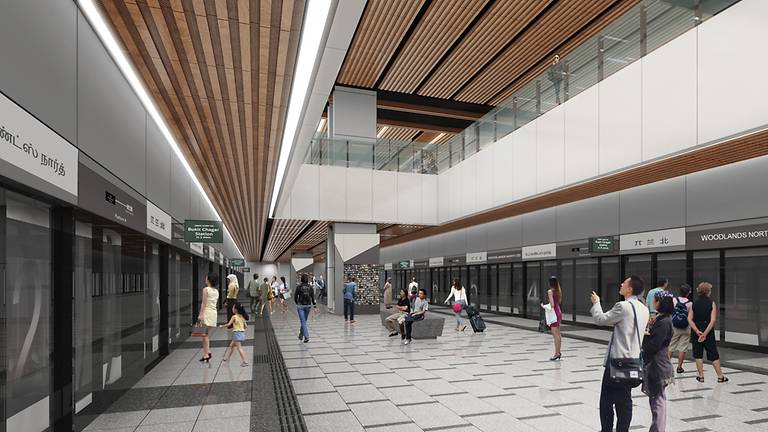
Artist’s impression of the train platforms at the RTS Link Woodlands North Station. (Image: LTA)
Each country will appoint an Infrastructure Company (InfraCo) to fund, build, own, maintain and renew the civil infrastructure and stations within their territories. In Malaysia, the InfraCo will be Prasarana Malaysia Berhad, while LTA will be Singapore's InfraCo.
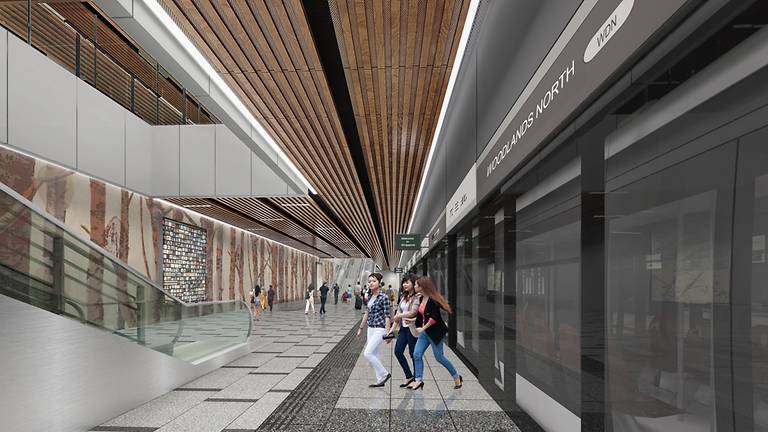
Artist’s impression of the train platforms at the RTS Link Woodlands North Station. (Image: LTA)
Both governments will also jointly appoint an operating company (OpCo) to own, design, build, finance, operate, maintain and renew the RTS Link's operating assets such as trains, tracks and systems.
The OpCo will pay a concession fee to the two countries in exchange for the right to collect fare revenue from operating the Link. The authorities said fares will be set on a commercial basis by the OpCo and not regulated by the two governments.
Under the terms of the agreement, the OpCo for the first concession period of 30 years, will be a joint venture between a Malaysian and a Singaporean company. These companies are Prasarana from Malaysia and SMRT Corporation in Singapore. "The companies have committed to incorporate the JV (Joint Venture) by 30 June 2018, and to sign the concession agreement by 30 September 2018. Subsequent concessions will be awarded through open tender," the statement said.
7 things to know about the upcoming Johor Baru-Singapore Rapid Transit System Link
1. THERE WILL BE A TRAIN EVERY 8 MINUTES
When it is ready by Dec 31, 2024, commuters can hop on a train every eight minutes on average. Trains will eventually arrive every four minutes on average during peak periods. The line will start with five trains, and gradually have a total fleet of seven trains. The link can carry up to 10,000 passengers per hour in each direction. This means 60,000 additional commuters will be able to cross the Causeway during peak hours. Currently, an average of 300 passengers travel in each direction per hour using the daily shuttle train service between Woodlands and Johor Baru.
2. START YOUR JOURNEY AT WOODLANDS NORTH
The line will link Bukit Chagar station in Johor Baru, near Sentral train station, to the Singapore terminus in Woodlands North, where commuters can transfer to the upcoming Thomson-East Coast MRT Line (TEL). The TEL is expected to open in phases from 2019 to 2024, and will comprise 31 stations stretching from Woodlands in the North to Sungei Bedok.
3. PASSENGERS NEED TO CLEAR CUSTOMS ONLY ONCE
The link will have a joint customs, immigration and quarantine facility at both terminus stations. Passengers who are crossing the border will need to clear customs and immigration only when they depart from either Singapore or Malaysia.
4. THE 4KM LINK WILL CROSS THE STRAITS OF JOHOR VIA A 25M-HIGH BRIDGE
The tracks will cross the Strait of Johor in a straight line rather than curving over water, taking into account the Johor Sultan's earlier reservations about the project. It will make a bend over land in Malaysia instead.
5. FARES WILL BE SET BY JOINT VENTURE COMPANY
Fares will be set by the joint venture company between SMRT and Prasarana Malaysia. It will not be regulated by the two governments.
6. THE END OF KTM SHUTTLE TRAIN
Within six months after the link starts operations, the Keretapi Tanah Melayu Tebrau (KTM) Shuttle will cease. The KTM train service has been running 26 daily trips since June 1 last year to cope with higher demand.
7. POSSIBLE REDEVELOPMENT OF WOODLANDS CHECKPOINT
Last August, Mr Khaw said the opening of the link will allow the Woodlands Checkpoint to be redeveloped, after the train shuttle service ends and land is freed up. "Then, hopefully, this problem of the Causeway jam can be significantly mitigated or even eliminated," he had said.
(新山30日07月2020讯)越堤族千盼万唤的马新捷运(RTS)工程终于正式恢复, 明年动工, 2026年底通车!
今天10am, 马来西亚和新加坡之间的3项协议签署仪式在新柔长堤举行,由我国首相和新加坡总理见证,新柔地铁工程正式恢复,将改为中型地铁系统但承载量不变,仍是每小时单向承载1万人。 李显龙总理和马来西亚首相慕尤丁见证了今早的仪式。新任交通部长王乙康和马来西亚交通部长魏家祥共同重启项目。在场的还包括外交部长维文医生和前基础建设统筹部长兼交通部长许文远,马方则有国际贸易及工业部高级部长阿兹敏、外长希山慕丁及柔佛州务大臣哈斯尼莫哈末。
恢复工程所需的三份协定都已缔结,即:新柔地铁双边协定、新加坡SMRT企业与马来西亚国家基础建设公司关于成立合资运营公司的协定,以及特许经营协定。 两国指,新柔地铁工程成功恢复,凸显新马深厚长久的双边关系,以及加强互利共赢合作关系的共同愿望。 新柔地铁完工后,将舒缓长堤堵塞情况,改善两地之间的联通性,并加强民间交流和创造共同的经济和社会利益。
柔佛新加坡捷运系统的建造计划预计将在2021年1月份开始,并预计于2026年底开始营运。柔佛新加坡捷运系统的建造会分成两个阶段进行,即从2021年初至2024年尾的开发以及土木结构的建造。 ”从2025年初至2026年尾则是系统构建的各个阶段,例如信号传输、列车、电信、调试甚至系统测试。“ 这项工程标志着马新在交通建设方面跨前一大步,相信这是柔佛人其中一个梦寐以求的目标。一旦竣工,将会解决长堤阻塞的问题。
在2018年初,当时建议的是建造捷运(MRT)系统,但在考虑了多方面的因素,由轻快铁取代。 之前,在获得柔州苏丹依布拉欣陛下捐献位于新山市区的武吉查卡地段,以及重新检讨整个计划的建筑成本后,大马将耗资31亿6000万令吉重新启动马新捷运计划,比原本预估的49亿3000万令吉,省下17亿7000万令吉或36%。
现在,柔佛新加坡捷运系统的建造费总共是37亿令吉,另5亿是其它基建工程费用, 在新山瓦迪哈那兴建维修基地。 这些成本在前朝政府是未估算的数目。交通部长拿督斯里魏家祥指出,柔新捷运系统在两国各有一个关税、移民与检疫设施(CIQ),乘客只需要在出发地完成一次出入境程序,即可通关。 他举例,从新山前往新加坡的大马民众,只要在武吉查卡的关卡设施完成通关程序,乘坐柔新捷运抵达新山兀兰北捷运站后,无需再次进行通关程序。 “我国将派出官员到新加坡的关卡设施执勤,新山武吉查卡捷运站的关卡设施也会有新加坡官员驻守。” 他透露,新山武吉查卡捷运站的关卡设施,预计将提供1500个停车位。 他补充,有关地段属于公共交通导向发展项目(TOD),因此将会有基本的商业设施,确保充分利用所有空间。
针对柔新捷运系统的车资,魏家祥也说,政府将把低收入群体及通勤族列入考量,因此不会太贵(Costly),也不是早前流传的10新元车资。 另外,询及未来柔新捷运系统是否会取代地不佬接驳火车(Tebrau Shuttle),魏家祥仅说,柔新捷运在2026年完工后,载客量和效率都将高于地不佬接驳火车。 魏家祥是于今早出席柔新捷运系统签约仪式后,在新山双木逸林酒店召开的新闻发佈会上,如是指出。
成立联营公司
马新捷运计划将继续由国家基建公司(Prasarana Malaysia Bhd)与新加坡SMRT Corp成立一家联营公司,共同操作捷运系统工程项目。 该联营公司将负责设计、建设、融资、营运、维护和更新RTS Link营运资产,如火车、轨道和系统。 根据交通部发出的文告,捷运公司(MRT Corp(与其子公司必须受委托为铁路基建公司,负责基建工程桥梁、车站及关税、移民厅及检疫中心(CIQ)建筑。
捷运公司与PMB在巴生谷,都拥有发展及营运铁路的纪录,这两家公司都是由大马政府通过财政部企业拥有。 交通部长表示,政府致力于解决马新长堤的交通拥堵问题,相信马新捷运将为成千上万越堤族提供快速,可靠和负担得起的服务,节省通勤时间。